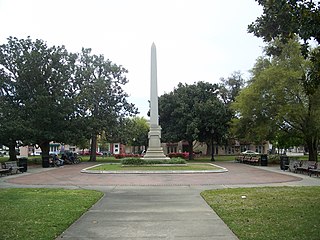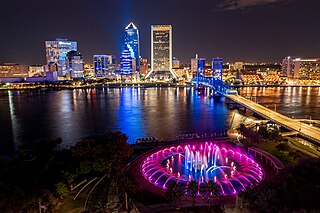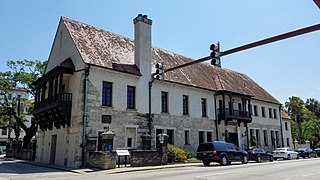
The French Quarter, also known as the Vieux Carré, is the oldest neighborhood in the city of New Orleans. After New Orleans was founded in 1718 by Jean-Baptiste Le Moyne de Bienville, the city developed around the Vieux Carré, a central square. The district is more commonly called the French Quarter today, or simply "The Quarter", related to changes in the city with American immigration after the 1803 Louisiana Purchase. Most of the extant historic buildings were constructed either in the late 18th century, during the city's period of Spanish rule, or were built during the first half of the 19th century, after U.S. purchase and statehood.

St. Augustine is a city in and the county seat of St. Johns County located 40 miles south of downtown Jacksonville. The city is on the Atlantic coast of northeastern Florida. Founded in 1565 by Spanish explorers, it is the oldest continuously inhabited European-established settlement in what is now the contiguous United States.

Old San Juan is a historic district located at the "northwest triangle" of the islet of San Juan in San Juan. Its area roughly correlates to the Ballajá, Catedral, Marina, Mercado, San Cristóbal, and San Francisco sub-barrios (sub-districts) of barrio San Juan Antiguo in the municipality of San Juan, Puerto Rico. Old San Juan is the oldest settlement within Puerto Rico and the historic colonial district of the city of San Juan. This historic district is a National Historic Landmark District and is listed on the United States National Register of Historic Places as the Old San Juan Historic District. Several historical buildings and structures, particularly La Fortaleza, the city walls, and El Morro and San Cristóbal castles, have been inscribed in the UNESCO World Heritage Site list since 1983. Historically the mixed use commercial and residential real estate in the main streets like Cristo Street, Fortaleza Street (north) from Tanca Street to the Governor’s Mansion is the most valuable in the area and it has kept its value and increased steadily through several years despite the past economic turmoils.

Fort Matanzas National Monument was designated a United States National Monument on October 15, 1924. The monument consists of a 1740 Spanish fort called Fort Matanzas, and about 100 acres (0.4 km2) of salt marsh and barrier islands along the Matanzas River on the northern Atlantic coast of Florida. It is operated by the National Park Service in conjunction with the Castillo de San Marcos National Monument in the city of St. Augustine.

The Plaza Ferdinand VII is an outdoor garden and park in the Historic Pensacola Village area of downtown Pensacola, Florida. It is located on Palafox Street between Government and Zaragoza Streets. It was named after Ferdinand VII of Spain, the King of Spain between 1813 and 1833. A National Historic Landmark, it is the site of the formal transfer of Florida to United States jurisdiction in 1821.

Jackson Square, formerly the Place d'Armes (French) or Plaza de Armas (Spanish), is a historic park in the French Quarter of New Orleans, Louisiana. It was declared a National Historic Landmark in 1960, for its central role in the city's history, and as the site where in 1803 Louisiana was made United States territory pursuant to the Louisiana Purchase. In 2012 the American Planning Association designated Jackson Square as one of the Great Public Spaces in the United States.

Downtown Jacksonville is the historic core and central business district (CBD) of Jacksonville, Florida. It comprises the earliest area of the city to be developed and is located in its geographic center along the narrowing point of the St. Johns River.

The Llambias House is a historic house located at 31 Saint Francis Street in St. Augustine, Florida. Built sometime before 1763, it is one of the few houses in Florida to survive from the first period of Spanish Florida. It was designated a National Historic Landmark on April 15, 1970. The house is now managed by the St. Augustine Historical Society as an event venue.

The González–Álvarez House, also known as The Oldest House, is a historic house museum at 14 St. Francis Street in St. Augustine, Florida. With a construction history dating to about 1723, it is believed to be the oldest surviving house in St. Augustine. It is also an important example of St. Augustine's Spanish colonial architectural style, with later modifications by English owners. It was designated a U.S. National Historic Landmark in 1970. The house is now owned by the St. Augustine Historical Society and is open for public tours as part of the Oldest House Museum Complex. Evidence can be seen of the Spanish, British, and American occupations of St. Augustine.

The Cathedral Basilica of St. Augustine is a historic cathedral in St. Augustine, Florida, and the seat of the Catholic Bishop of St. Augustine. It is located at 38 Cathedral Place between Charlotte and St. George Streets. Constructed over five years (1793–1797), it was designated a U.S. National Historic Landmark on April 15, 1970. Its congregation, established in 1565, is the oldest Christian congregation in the contiguous United States.

Ximenez-Fatio House Museum is one of the best-preserved and most authentic Second Spanish Period (1783-1821) residential buildings in St. Augustine, Florida. In 1973, it was added to the National Register of Historic Places. It was designated a Florida Heritage Landmark in 2012.

The Santa Fe Plaza is a National Historic Landmark in downtown Santa Fe, New Mexico in the style of traditional Spanish-American colonial cities. The plaza, or city square is a gathering place for locals and also a tourist attraction. It is home to annual events including Fiestas de Santa Fe, the Spanish Market, the Santa Fe Bandstand, and the Santa Fe Indian Market.

The Presbytère is an architecturally important building in the French Quarter of New Orleans, Louisiana. It stands facing Jackson Square, adjacent to the St. Louis Cathedral. Built in 1813 as a matching structure for the Cabildo, which flanks the cathedral on the other side, it is one of the nation's best examples of formal colonial Spanish architecture. It was designated a National Historic Landmark in 1970, and is now a property of the Louisiana State Museum.

Downtown Santa Ana (DTSA), also called Downtown Orange County, is the city center of Santa Ana, the county seat of Orange County, California. It is the institutional center for the city of Santa Ana as well as Orange County, a retail and business hub, and has in recent years developed rapidly as a regional cultural, entertainment and culinary center for Orange County.

The Barrio de Analco Historic District is a National Historic Landmark District centered at the junction of East De Vargas Street and Old Santa Fe Trail in Santa Fe, New Mexico. The seven buildings of the district represent one of the oldest clusters of what were basically working-class or lower-class residences in North America, and are in a cross-section of pre-statehood architectural styles. It includes two of the oldest colonial-era buildings in the southwest, the San Miguel Mission church (1710), and the "Oldest House", built in 1620 and now a museum. The district was declared a National Historic Landmark in 1968.

The Ste. Genevieve National Historical Park, established in 2020, consists of part or the whole of the area of the Ste. Genevieve Historic District, which is a historic district encompassing much of the built environment of Ste. Genevieve, Missouri, United States. The city was in the late 18th century the capital of Spanish Louisiana, and, at its original location a few miles south, capital of French Louisiana as well. A large area of the city, including fields along the Mississippi River, is a National Historic Landmark District designated in 1960, for its historically French architecture and land-use patterns, while a smaller area, encompassing the parts of the city historically important between about 1790 and 1950, was named separately to the National Register of Historic Places in 2002.

Stanbury Cottage is a historic building at 232 St. George Street in St. Augustine, Florida. It is part of the St. Augustine Town Plan Historic District. On October 8, 2008, it was added to the U.S. National Register of Historic Places. Stanbury Cottage is one of the oldest examples of Carpenter Gothic architecture in Florida. The house has historic connections to Henry Flagler, Andrew Anderson, and Martin J. Heade who were often guests of the Stanburys.

Government House, also known as Governor's House, is located at 48 King Street in St. Augustine, Florida, adjacent to the Plaza de la Constitución. The building, constructed of coquina, served as the governor's official residence from c. 1710 during the First Spanish Period (1565–1763), throughout the British Period (1763–1784), and until 1812 in the Second Spanish Period (1784–1821). Governor Gonzalo Méndez de Canzo was the first governor to build his residence on the present Government House site in 1598.
St. Augustine, Florida, the oldest continuously occupied settlement of European origin in the continental United States, was founded in 1565 by Spanish admiral Pedro Menéndez de Avilés. The Spanish Crown issued an asiento to Menéndez, signed by King Philip II on March 20, 1565, granting him various titles, including that of adelantado of Florida, and expansive privileges to exploit the lands in the vast territory of Spanish Florida, called La Florida by the Spaniards. This contract directed Menéndez to explore the region's Atlantic coast and report on its features, with the object of finding a suitable location to establish a permanent colony from which the Spanish treasure fleet could be defended and Spain's claimed territories in North America protected against incursions by other European powers.

The Paredes-Dodge House is located at 54 St. George Street in St. Augustine, Florida. The one and a half story structure was built between 1803 and 1813, and is one of the only surviving colonial structures in St. Augustine.




























